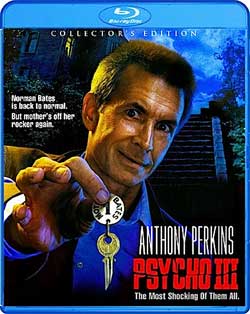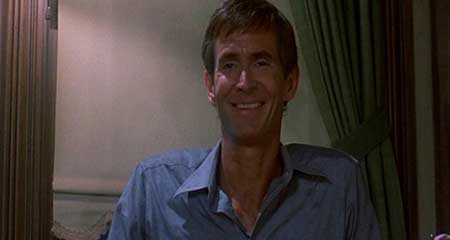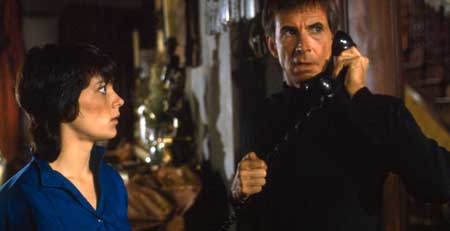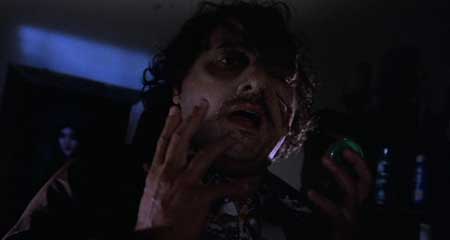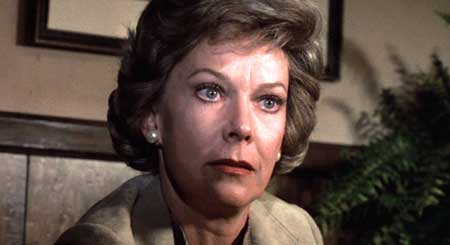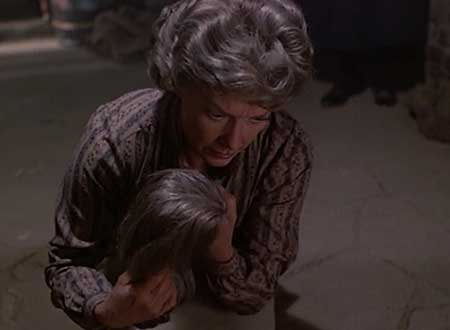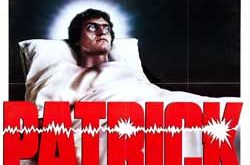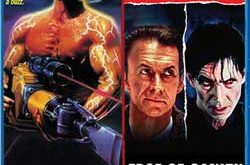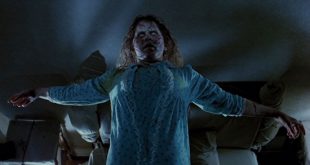After twenty-two years of psychiatric care, Norman Bates attempts to return to a life of solitude… but the specters of his crimes — and his mother — continue to haunt him.
REVIEW:
“Goodnight, Mary.”
The original film (directed by Alfred Hitchcock in 1960) was essentially the first slasher film and, in turn, initiated a new avenue of horror that has, by now, become passé (though, nonetheless, commercially successful). The manipulative nature of Hitchcock’s first film (daresay, the majority of his film making career) is joyously retained here. Not in any way related to Robert Bloch’s (the author of the novel) sequel (in his version, Bates escapes from the mental asylum disguised as a nun and moves to Hollywood where a film based on his murders is being filmed); Franklin’s Psycho II is equal parts sequel, homage, and parody but rejects this plot entirely.
The film begins with a flashback of the notorious shower scene and the Bates’ Victorian house is there in all its splendor – but that is where the comparisons end. Though an homage film, it seems as if the audience is given more time to breathe outside of the mostly claustrophobic setting of the first film. We spend some time in town, at the police station – pretty much the same locales as the first but a bit more relaxed. The references that crop up are often parodied, so it’s all very self-aware.
Twenty-two years after the events of the first film, Norman Bates has been freed from the mental asylum he was once admitted. The court ruled him not guilty by cause of insanity but there are still those in town who believe him to be an aware and dangerous killer. One such person is Lila Loomis (played by Vera Miles), the sister of Marion Crane (Bates’ infamous shower victim in the first film) who makes frequent appearances throughout the film. Bates gets a job at a diner but a heckler (Dennis Franz) rustles up painful memories. Bates meets a woman and she stays with him at the house, their relationship ultimately becoming romantic.
Strange things begin to happen: mother calls him on the telephone, he finds notes strewn about signed “Mother,” murders occur. Of course, suspicion immediately falls upon him and he must sort out the copycat killings while battling his own inner demons (or is this “copycat” just another of his rationalisations?).
Norman is the same quirky, obsessive character; his rehabilitation having served more as a personal reformation than punishment, portrayed by Perkins as having a genuine yearning to live a normal life devoid of mother’s hauntings. He is also a wildly unpredictable personality with the tendency to lapse into a murderous state at any moment. The intense scenes in the film are handled with the appropriate amount of urgency and apprehension but there’s a lot of camp as well. Perkins plays Norman quite dryly, which isn’t to say that there isn’t a fair dose of humour but that contributes to the film’s quirky charm. One must remember, Franklin’s adaptation (written by Tom Holland) varies greatly from Bloch’s successful literary sequel (which involves Norman Bates more spiritually than psychically and was more of a shun to Hollywood); a cash cow that transcended its initial purpose.
Franklin has often been a surprising filmmaker. Beginning with his second film, Patrick, he led an interesting career in cinema but Psycho II is his greatest achievement; a sequel that not only progresses from the first fluidly but ends with a satisfying climax (and, perhaps, anticlimax).
Of course, the inclusion of Anthony Perkins was half the battle and he is in top form here. There is a wonderful moment, near the end of the film, where Dutch angles pervade, symbolising the fragile core of Norman’s mind as it steadily crumbles.
Or the recreation of alluding shots, leading the audiences’ expectations down a path that, while once validated, become merely red herrings. Franklin does a lot of this which is much of the reason why the film holds up under multiple viewings and succeeds as a sequel; it is reflective and allegoric but not harping, not stagnant. Franklin takes few missteps with this work, especially considering it is the first follow-up to a highly influential and well-known film; this one joining that short list of effective sequels that also stand well enough on their own merit.
Rating: A-
 Horror News | HNN Official Site | Horror Movies,Trailers, Reviews
Horror News | HNN Official Site | Horror Movies,Trailers, Reviews
